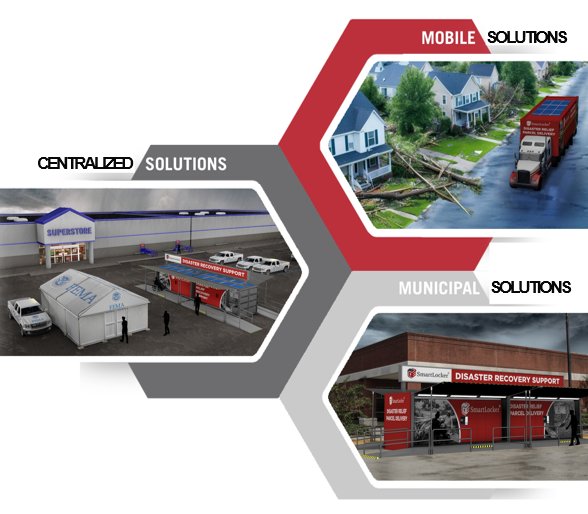Disaster Services
Disaster Recovery Support Solution
Automate the Contactless Exchange of Physical goods with complete chain of custody
Full Integration
-Leverage technology to enable FEMA be Disaster Ready
-Logistics Supply Chain Management System (LSCMS)
-Disaster Response and Recovery Tools (DRRT)
-Global Positioning System (GPS) and Radio Frequency Identification (RFID)
-Integrated Remote Mobile Device Management for support and updates.
-ISO 27001 Certified solution
-SOC II Compliance certified solution
-RESTful API integration with other back-end solution
Establish
-Micro-Logistics platform to provide just in time resources
Manage Inventory
-Executive Dashboarding
-Real Time Analytics
-Robust Reporting
-1:1 relationship with RFID to Locker Door for complete chain of custody
-Expand thoughts
Access
-Mobile/ Drop Ship Containerized SmartLocker Deployment
– 24/7 I 365
-Contactless and Secure delivery
– Interactive Digital Information Boards and Community Updates (Located on side of Container)

Addressed Hazards:
- Hurricane
- Fire
- Earthquake
- Flood
- Earthquake
- Epidemics
- Terrorism
- Drought
- Integrated Remote Mobile Device Management for support and updates.
- ISO 27001 Certified solution
- SOC II Compliance certified solution
Disaster Recovery Support Solution
Details
Objective: Establish a reliable and secure smart locker system for the storage and distribution of essential supplies during disaster recovery efforts.
Scope: Implementation of smart locker systems in strategically chosen locations prone to natural
disasters to streamline aid distribution.
Technology: Use of state-of-the-art, weather-resistant smart lockers equipped with real-time tracking and remote access capabilities
Funding Sources
Government Grants: Exploring federal and state emergency management funding opportunities.
Private Donations: Partnership with corporate donors and private foundations interested in disaster management solutions.
Public-Private Partnerships: Leveraging support from technology companies in exchange for data insights and testing grounds for
new technologies.
Partnership Project Timeline
Phase 1 - Planning and Funding (Months 1-3): Securing partnerships and funding, finalizing locations for locker installations.
Phase 2 - Implementation (Months 4-6): Purchasing and
installing lockers, integrating systems, and training staff.
Phase 3 - Launch and Evaluation (Months 7-12): Going live with initial sites, collecting data, and making adjustments based on feedback.
Cost
Initial Setup: Cost includes purchasing smart lockers, installation, and integration with existing disaster management systems.
Maintenance: Annual maintenance fee covering repairs, software updates, and technical support.
Operational: Regular operational costs such as power supply, connectivity, and security monitoring.
Benefits
Speed and Efficiency: Quick distribution of essential items, reducing bottlenecks in traditional disaster relief supply chains.
Accessibility: 24/7 access to supplies with secure authentication methods to ensure they reach the right people.
Accountability and Tracking: Enhanced tracking and reporting capabilities to monitor usage patterns and stock levels, improving response strategies.
Challenges Faced
Logistical: Identifying and securing optimal locations for locker installations to maximize reach and effectiveness.
Technical: Ensuring compatibility of smart locker technology with various disaster recovery software systems.
Security: Maintaining high security to prevent unauthorized access and vandalism.

Disaster Recovery Support Solution
Resources and References:
Case Studies: Review of similar implementations and their outcomes in different regions.
Technical Specifications: Detailed documentation of locker technology and software integration.
Policy Framework: Overview of regulatory considerations and compliance requirements for disaster response technologies.

